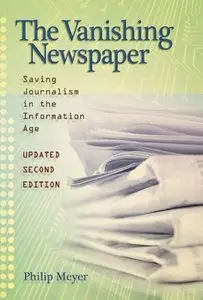The Vanishing Newspaper [2nd Ed]: Saving Journalism in the Information Age, Second Edition by Philip Meyer
2009 | ISBN: 082621858X, 0826218776 | English | 264 pages | EPUB | 2 MB
2009 | ISBN: 082621858X, 0826218776 | English | 264 pages | EPUB | 2 MB
Five years ago in The Vanishing Newspaper, Philip Meyer offered the newspaper industry a business model for preserving and stabilizing the social responsibility functions of the press in a way that could outlast technology-driven changes in media forms. Now he has updated this groundbreaking volume, taking current declines in circulation and the number of dailies into consideration and offering a greater variety of ways to save journalism.
Meyer’s “influence model” is based on the premise that a newspaper’s main product is not news or information, but influence: societal influence, which is not for sale, and commercial influence, which is. The model is supported by an abundance of empirical evidence, including statistical assessments of the quality and influence of the journalist’s product, as well as its effects on business success.
Meyer now applies this empirical evidence to recent developments, such as the impact of Craigslist and current trends in information technologies. New charts show how a surge in newsroom employment propped up readership in the 1980s, and data on the effects of newsroom desegregation are now included. Meyer’s most controversial suggestion, making certification available for reporters and editors, has been gaining ground. This new edition discusses several examples of certificate programs that are emerging in organizations both old and new.
Understanding the relationship between quality and profit probably will not save traditional newspapers, but Meyer argues that such knowledge can guide new media enterprises. He believes that we have the tools to sustain high-quality journalism and preserve its unique social functions, though in a transformed way.



